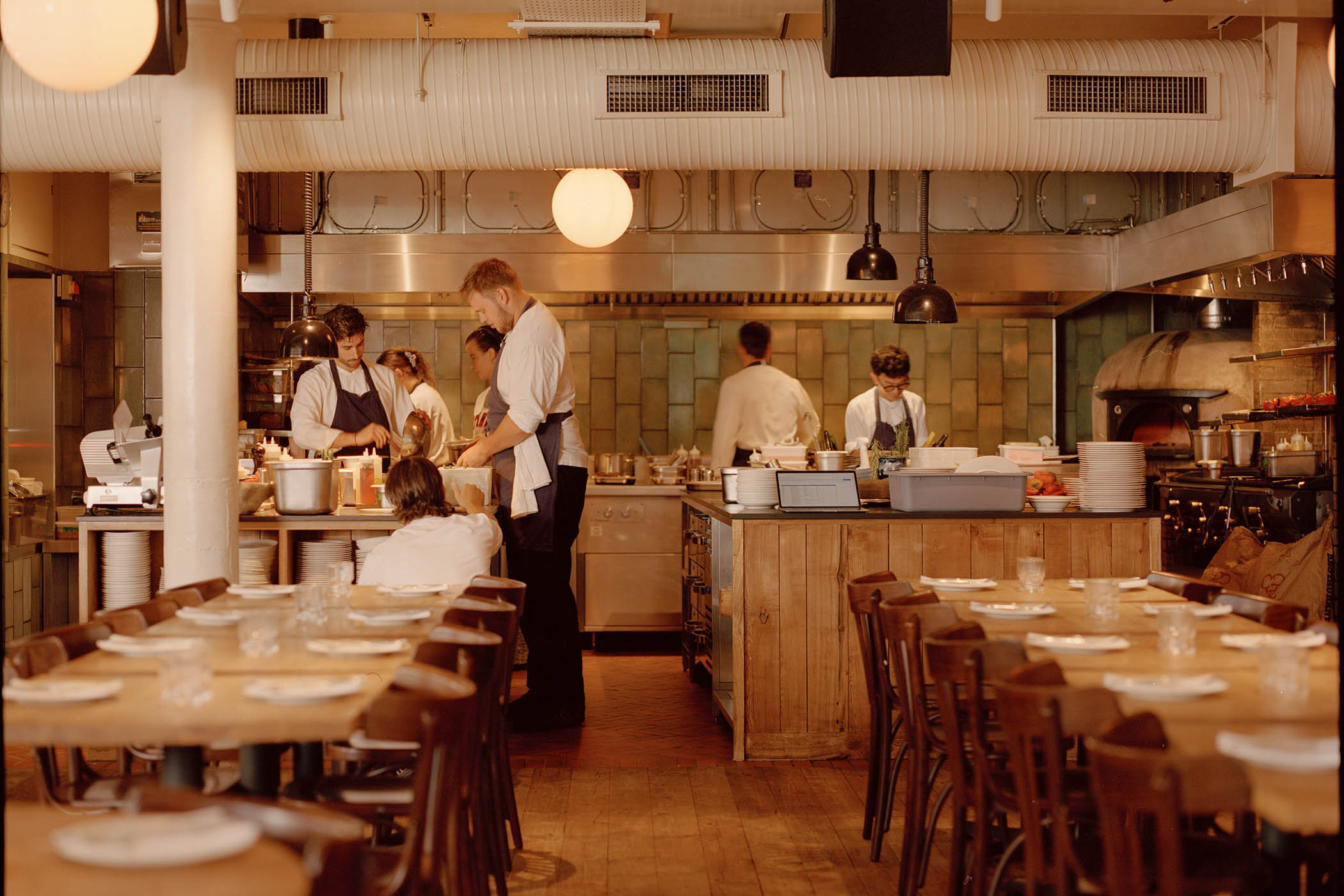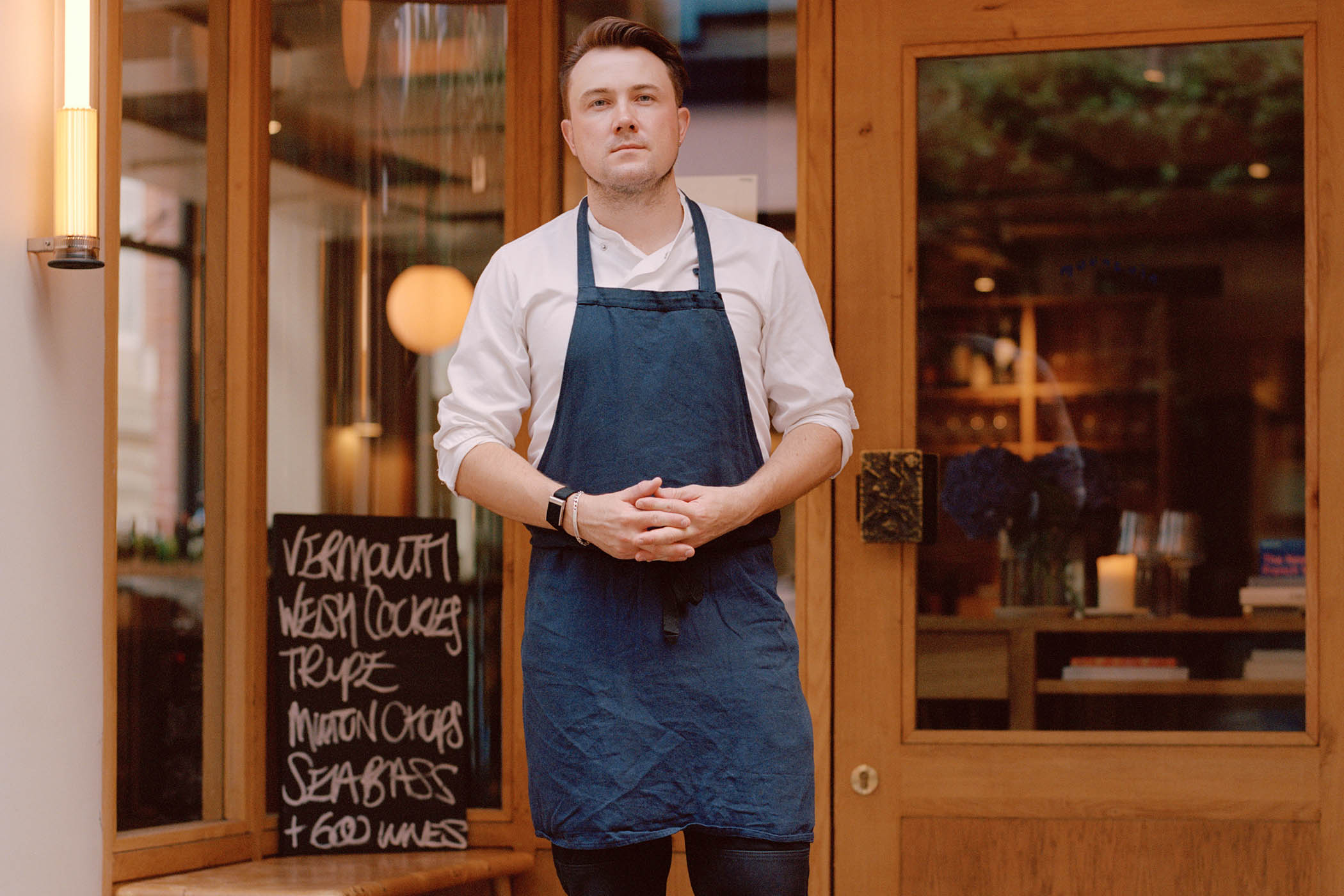Photographs Cian Oba-Smith
There is a confidence, almost a zero-fucks swagger, to the menu at the Soho restaurant Mountain. Take the line: “Tripe… 18.” That’s it. No embellishment or soft-pedalling or confusion here. No hard-sell that the dish has been on the menu since the restaurant opened two years ago, or that it is made from two types of beef stomach (two!), as well as trotters, cured meat, vinegar, smoky and sweet paprika, or that it is braised slowly over a couple of days. It doesn’t say that it is probably the finest representation of this dish you’ll find outside a secret Basque dining club, or that when legendary chef Pierre Koffmann ate at Mountain he pronounced the tripe “delicious” and tried (without success) to give momentum to the hashtag “choosetripe”.
“Tripe… 18.” Not even a £ sign.
The rest of the menu at Mountain is similarly uncompromising. “Chickpeas with snails… 19.5” is comparatively grandiloquent, giving you two ingredients. Fancy some “Pembrokeshire cockles... 15”? How about: “Wild Mushrooms… 19.” If this all sounds a bit Bushtucker Trial, Mountain will also serve you one of the great steaks of your life. And native fish, such as John Dory and Dover sole, cooked simply and splendidly over a wood-fired grill. Also, a spider crab omelette, brushed with butter and seaweed from Pembrokeshire, images of which have been all over social media recently, partly because you are encouraged to scalpel the omelette lengthwise, leaving you feeling like a surgeon doing a field operation.
But the effect of this simplicity, as a diner reading the menu at Mountain, is to feel intensely the supreme confidence of a chef and team at the top of their game. After ordering lunch recently, my friend and I actually high-fived, so sure were we that we were on the cusp of a hall-of-fame meal.
That chef, by the way, is 39-year-old Tomos Parry, from north Wales. “There’s a heavy influence from northern Spanish bars,” he says of the menu. We’re meeting for a cup of tea at a café round the corner from Mountain; at 3pm, the restaurant is still too noisy during a prolonged and heaving lunch service to record an interview. “A lot of the time, when you go to the blackboard menus in northern Spain, there’s no dish description,” he goes on. “They’ll just write ‘tripe’ or ‘snails with chickpeas’. And if it says tripe, you’re getting tripe. If it says snails and chickpeas, it’s a massive bowl of snails with chickpeas. I like that clarity, and I think people find comfort in that zone.”
If you haven’t heard of Parry, that is because the man – like the menu – is understated. He doesn’t turn up endlessly on the carousel of TV food shows. His public pronouncements, when they come, seem considered and thoughtful. He appears genuinely, unfashionably, to be happiest behind the stove at one of his restaurants. In person, he projects mostly as egoless, which is not a word you often have cause to use in a chef profile.

‘Before opening Brat I thought, “God, are people going to think this is too simple”’: Tomos Parry’s latest hit, Mountain, opened in 2023
And yet he has quietly compiled a near-impeccable food CV. Coming up, he trained at the best of the best: the Ledbury, Ruth Rogers’s River Café, and under Rene Redzepi at Noma, in Copenhagen. In the mid-2010s he was poached to become head chef of Kitty Fisher’s, in Mayfair, and his two years there coincided with the restaurant becoming the hardest place to snag a table in London.
Then in March 2018, Parry opened his own place, Brat, in Shoreditch, where he cooked super-seasonal British produce over a grill in a tiny kitchen. Brat won a Michelin star within six months. Not long after, it appeared on a list of the 100 best restaurants in the world.
Mountain, which is double the size of Brat, followed in 2023. It also earned the Michelin nod within six months. And, again, it landed a spot on the world’s best restaurants list not long after. (It currently ranks 74.) Parry also runs Brat x Climpson’s Arch in London Fields, which was born in 2020 as a pandemic pop-up, but like everything he does turned out to be more successful than anyone – including Parry – predicted.
I first met Parry in June 2018 – the original “Brat summer” – when I interviewed him for the cover of an issue of the Observer Food Monthly that called him “Britain’s hottest chef”.
Back then, I described him as “bemused” by the attention he was receiving, which included critics Giles Coren describing Brat as “the most exciting new restaurant in Europe” and Jay Rayner comparing eating there to Anthony Hopkins’s performance in Remains of the Day.
Parry today agrees “bemused” was the right word. When he decided to open his own restaurant, he “thought it would be good,” he says, “because I worked so hard at it,” and “I was determined to make it a worthwhile place for people to come and eat.”
But Parry found other people’s reactions almost overwhelming. “It’s quite a simple concept,” he continues. “It’s just good produce cooked over fire in a great room. We’re not doing a thousand things to the ingredients.”
Kitchens have changed in the last 20 years. And it’s great that AI can’t come for our jobs. It might try, but there’s no way it’s cooking over fire
He sips his tea, shakes his head. “Before opening Brat I was a bit worried,” he says. “I thought, ‘God, are people going to think this is too simple.’”
It turns out he couldn’t have been more wrong.
Parry grew up in Anglesey, where his mother was a nurse and his father was an engineer who also volunteered on the lifeboats. There was not much of a food scene in north Wales at that time, so Parry schooled himself on newspaper supplements. “I was back at home last month, helping my mum move house, and I found a pile this high of OFMs from 20-odd years ago,” he says, gesturing almost to his waist. “Before Instagram, and especially if you didn’t live in London, that was the only way you could access what was going on in the food world.”
At 14, Parry started working in local restaurants, cleaning mussels, but couldn’t see a future in it, so he went to study history and politics at Cardiff University. Pretty soon he realised his mistake, though he finished his course, working unpaid shifts at a French restaurant in Pontcanna. “I had massive debts,” he sighs. “And I was pissed off with myself. I thought, ‘I love food. Why didn’t I just do that from day one?’”
After graduating, Parry set about, very strategically, making up for lost time. He chose the Ledbury because he wanted to experience a restaurant that had two Michelin stars. The River Café was already iconic, and becoming well-known for its nurturing approach to its staff, so he spent a couple of years there. Then Noma, for a shorter stint, because “I wanted to see the world’s best restaurant at the time, what it all meant.”
Parry was a sponge for new experiences and ideas. While he was at the River Café, the dominant model in the London restaurant scene was shouty male chefs drilling their teams like army “brigades”. Parry saw it didn’t have to be like that and became determined that when – not if – he opened his own restaurant it wouldn’t be.
“The River Café is still a holy grail of service, of hospitality, of how you build culture,” he says. “They were doing the 40-hour week before anybody had even thought about it.”
For Parry, hospitality is finally winning the battle against tyrannical chefs and inhumane hours. When I ask him how he would feel if his children – a son aged eight, and his daughter, five, – told him that they wanted to be chefs? He insists he would be delighted.
“The culture is changing,” he says. “Kitchens are changing. It’s not the same as it was 20 years ago,” he laughs, “and the great thing is that AI can’t come for our jobs. It might try, but there’s no way it’s cooking over fire.”
Parry’s real culinary breakthrough, though, came at Noma. He had grown up on Anglesey cooking mackerel or oysters on a grill on the beach, or going hiking in the mountains and taking a stove. “Everyone used the barbecue,” he says. In Denmark, Parry found a similar impulse. “The Danes were cooking over fire. I was like, ‘Ah, yes, that’s the element I’ve been missing, isn’t it?’”
It’s slightly more complicated than that: there were years of research trips, mainly to the Basque Country and Mallorca, spent refining his cooking style. But clearly Rogers and Redzepi from Noma live somewhere rent-free in Parry’s head. “Clarity of vision,” he says. “That’s what it’s all about. I find them extremely inspiring.”
Parry hopes that diners discover the same spirit when they eat at Brat or Mountain. “I think what I’m good at, if I had to choose something,” he says – he is squirming now, I suppose at the idea of appearing boastful – “I just like to do a couple of things very well. And one of those things is cooking on fire. And, because I’m not trying to do different things every day, I feel like I’m getting better and better and better.”
I ask what the second thing is. “w We’re very good at being clear in our offer,” he says. “You’re not going to come to my restaurants and see lots of different cuisines on the menu. People like the fact that if they order fish, they get a fish.”
Tomos Parry in numbers
14 Age he began work in seafood bar
2019 Rugby world cup he cooked for in Tokyo
6 Months for Brat to get a Michelin star
25 Age he moved to London from Cardiff
20 years worked in restaurants
151,000 Brat’s Instagram followers
Brat, 4 Redchurch Street, London E1 (bratrestaurant.co.uk); Mountain, 16-18 Beak Street, London W1 (mountainbeakstreet.com). From November, Tomos will be writing a monthly food column in the Observer Magazine
